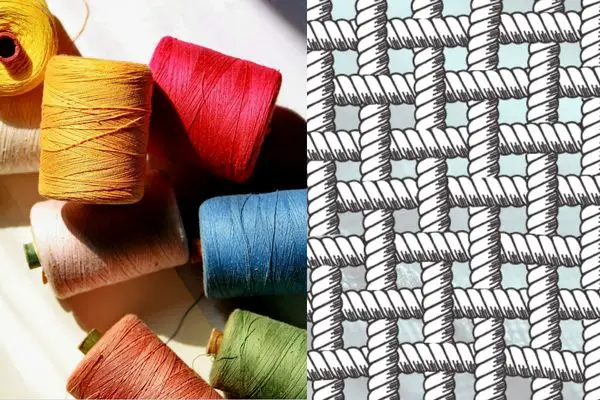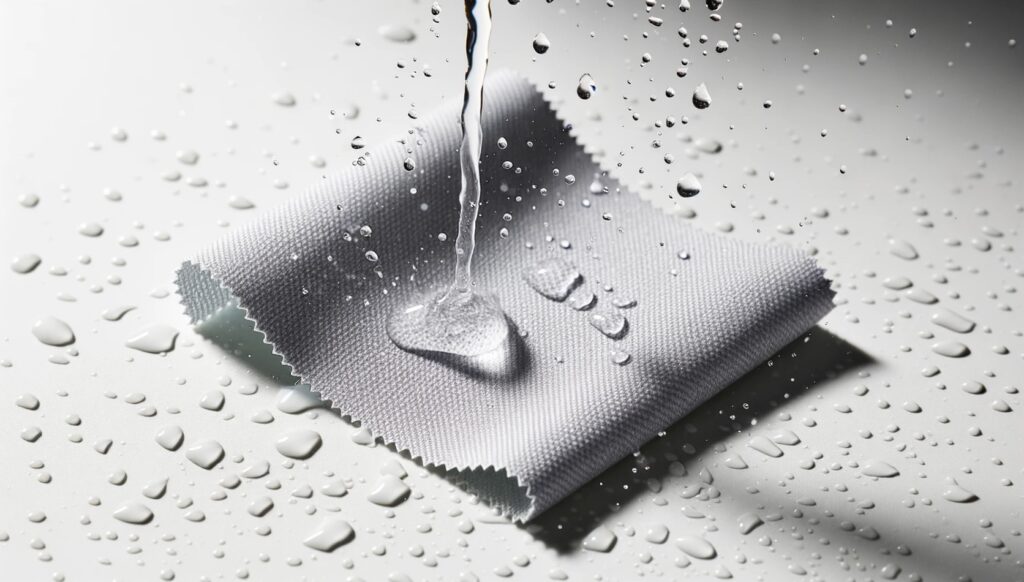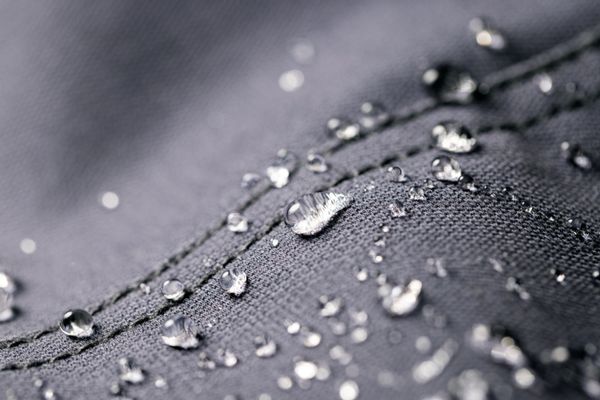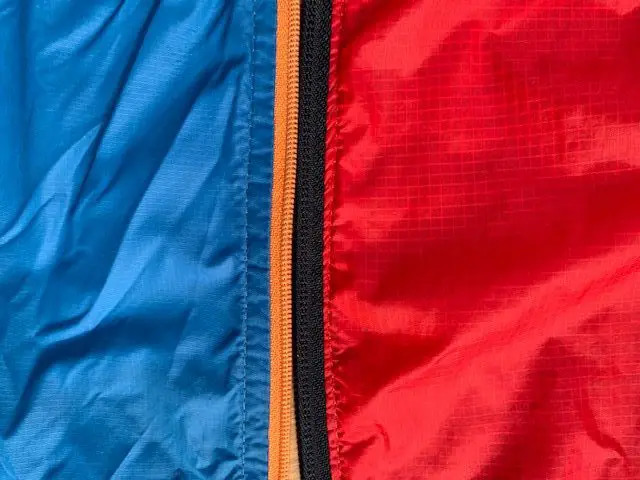When it comes to outdoor gear, the choice of fabric is crucial as it plays a significant role in ensuring comfort, durability, and protection against the elements.
Is 68D polyester really waterproof? The short answer is: Not entirely, but it exhibits a decent level of water resistance which can be improved with certain treatments. The fabric’s water resistance can be estimated at around 800 mm hydrostatic pressure.
68D polyester is a popular fabric used in the manufacturing of outdoor gear such as rain gear, jackets, pants, tents, and backpacks due to its lightweight and durable nature.
For outdoor enthusiasts, one major concern is how well this fabric can stand up against water.
Contents
Introduction to 68D Polyester
Polyester, in its essence, is a synthetic polymer derived from petroleum. It’s favored for its durability, wrinkle resistance, and affordability. There are multiple variants of polyester based on their manufacturing process and properties, but the common element is their polymer backbone, which lends the fabric its inherent characteristics.
The Significance of “68D” in Polyester Fabric
The term “D” stands for denier, which is a unit of measurement denoting the thickness of individual fibers or threads. A higher denier implies a thicker, more robust thread. In the context of 68D, it suggests a medium-thick thread that strikes a balance between strength and lightness.

Understanding the Water Resistance of 68D Polyester
68D refers to the thread count of polyester, indicating a standard density which strikes a balance between weight and durability.
Here’s how the fabric stands in terms of water-resistance:
- Water-Resistance: 68D polyester comes with a certain level of water resistance which is often enhanced through coatings or treatments like DWR (Durable Water Repellent).
- Coatings: There are different coatings like PU (Polyurethane) and PVC (Polyvinyl Chloride) that are applied to enhance the waterproofing capability of 68D polyester.
- Hydrostatic Pressure: The measure of water resistance, the 800 mm rating indicates that the fabric can withstand a 800mm or 31.5 inches column of water for more than a minute before it starts to leak.
The Inherent Water-Repelling Properties
Polyester, by nature, doesn’t absorb much water. However, it’s the gaps between the woven fibers that can allow water to seep in.

Thus, untreated 68D polyester may fend off light moisture but may not stand up to prolonged exposure.
Practical Tests and Field Performance
In real-world scenarios, 68D polyester gear, especially when treated, has shown commendable performance in warding off rain, especially in items like rain jackets, tents, and backpacks. However, for heavy rain or extended wet conditions, it’s essential to ensure the fabric is appropriately treated and seam-sealed.
Primary Uses of 68D Polyester
Outdoor Gear and Apparel
Given its balance between weight and strength, 68D polyester finds extensive use in rain gear, tents, backpacks, and lightweight jackets.

Everyday Items and Household Uses
This material also makes its way into umbrellas, patio furniture covers, and other items needing moderate water resistance.
Industrial and Technical Applications
Its durability makes 68D polyester suitable for industrial applications like protective covers and specialized equipment.
Fabric Strength and Durability
The denier of a fabric directly correlates with its strength and durability. Higher denier fabrics tend to be stronger but heavier, while lower denier fabrics are lighter but may wear out faster. At 68D, the polyester occupies a sweet spot, making it a favorite for outdoor equipment and apparel.
Factors Influencing 68D Polyester’s Durability
While denier plays a crucial role, several other factors influence durability:
- Weave type: A tighter weave often means better durability.
- Quality of yarn: Higher-grade polymers produce superior yarn.
- Coatings and treatments: These can enhance abrasion resistance and longevity.
How Thickness and Weight Affect Performance
Thicker and denser fabrics tend to be more durable and may offer better protection against elements like wind.

However, they can also be heavier, which might not be ideal for activities where weight is a concern, like backpacking.
The strength of the fabric is largely determined by its denier (D) count, and 68D polyester offers a good balance of strength and flexibility. Here’s a breakdown:
- Tensile Strength: The ability of the fabric to withstand pulling forces without tearing.
- Abrasion Resistance: 68D polyester fares well against wear and tear, making it ideal for rugged outdoor use.
Surface Treatment Options
Surface treatment further enhances the water resistance of 68D polyester:
- DWR (Durable Water Repellent): A common treatment that makes water bead up and roll off the fabric.
- PU (Polyurethane) Coating: This coating is often used to improve the waterproofing of the fabric, at the expense of breathability.
- PVC (Polyvinyl Chloride) Coating
- Silica-based Nanocoatings
- Infrared Reflective (IRR) Coatings
- Antimicrobial Finishes
The type of treatment can significantly alter a fabric’s water-resisting capabilities. For instance, a DWR-coated 68D polyester might resist light rain, but with an added polyurethane or PVC coating, it can withstand heavier downpours.
DWR (Durable Water Repellent) Coating
DWR is a common treatment applied to outdoor fabrics, including 68D polyester. It allows water to bead off the material’s surface, enhancing its water-resistance properties.

Polyurethane and PVC Coatings
Both coatings can be applied to the inner side of the fabric. They create a barrier, thereby improving water resistance. However, they can also add weight and reduce fabric breathability.

Advanced Treatments for 68D Polyester
In the quest for the ultimate outdoor gear, fabric treatments play an indispensable role. While we’ve already touched on DWR and coatings like polyurethane and PVC, there are even more advanced treatments available in the market.
Silica-based Nanocoatings
Recent advancements in nanotechnology have given rise to silica-based coatings, which offer superior water repellency without compromising fabric breathability. These coatings form a nano-layer on the fabric surface, causing water to bead up and roll off.
Infrared Reflective (IRR) Coatings
For those looking to stay camouflaged in outdoor settings, IRR coatings reduce the fabric’s infrared signature, making the wearer less visible to infrared detectors. This is especially handy for tactical applications.
Antimicrobial Finishes
For extended treks, antimicrobial treatments can be a boon. They prevent the growth of bacteria on the fabric, thereby reducing odors and increasing the overall lifespan of the gear.
Maintenance and Care of 68D Polyester
Ensuring the longevity and water resistance of your 68D polyester gear requires proper maintenance and care.
Whether you’re stowing away your tent after a long weekend in the woods or cleaning up a rain jacket, the way you treat your 68D polyester can significantly impact its durability and water resistance. Here’s a comprehensive guide to ensuring your gear remains in top-notch condition:
Cleaning 68D Polyester
- Gentle Wash: Always use a gentle cycle when machine washing 68D polyester items. It’s preferable to use cold water to prevent potential damage from high temperatures.
- Mild Detergents: Avoid harsh chemicals or bleaching agents. Instead, opt for a mild detergent or a specialized cleaner designed for outdoor gear.
- Hand Washing: For delicate items or those with multiple coatings, hand washing might be the best option. Use lukewarm water and gentle rubbing to get rid of dirt.
- Avoid Wringing: Instead, press the water out gently. Wringing can stress the fabric and deteriorate any coatings.
Drying 68D Polyester
- Air Dry: It’s best to let 68D polyester items air dry. Lay them flat or hang them away from direct sunlight to prevent UV damage.
- Tumble Dry – Use with Caution: If you must use a dryer, ensure it’s on a low heat setting. Excessive heat can melt or damage polyester fibers and coatings.
- No Ironing: Polyester’s synthetic nature means it doesn’t handle high heat well. Avoid ironing to prevent melting or altering the fabric structure.
Reapplying Treatments
- DWR Refresh: Over time, the DWR coating can wear off, especially with regular use and washing. Consider reapplying a DWR spray or wash-in product to keep your gear water repellent.
- Seam Sealers: For tents and jackets, inspect the seams regularly. If you notice any peeling or wear, use a seam sealer to ensure continued water resistance.
Storing 68D Polyester
- Dry Storage: Ensure your items are completely dry before storing them to prevent mold or mildew buildup.
- Loose Packing: For items like tents or sleeping bags, avoid compressing them too tightly. Instead, store them loosely to maintain fabric loft and integrity.
- Away from Sharp Objects: To prevent unintentional snags or tears, keep your 68D polyester items away from tools, knives, or any sharp edges.
- UV Protection: Continuous exposure to UV rays can weaken the fabric and reduce its lifespan. Store items in a dark, cool place when not in use.
General Tips
- Patch Up: Small tears or holes? Repair them promptly with patches or specialized repair tapes to prevent them from getting larger.
- Avoid Direct Contact with Flame: Polyester is flammable. Ensure that your gear is kept away from open flames or intense heat sources.
- Regular Inspection: Regularly inspect your 68D polyester items for any wear, tears, or potential issues. Early detection can lead to simpler, more effective repairs.
Comparing 68D Polyester with Similar Fabrics
68D Polyester vs. Higher Denier Polyesters
Higher denier polyesters, like 210D or 600D, are heavier and more robust. They might offer better abrasion resistance but could be overkill for some applications due to their weight.
68D Polyester vs. Nylon
Nylon is another favorite in the outdoor community. While it shares similarities with polyester, it’s generally softer, more breathable, but might absorb more water than polyester, especially without treatments.

Both polyester and nylon are popular materials for tent fabric, and each has its own set of advantages and disadvantages. Let’s compare the two based on several key criteria:
Water Resistance and Durability:
- Polyester: It is generally more UV resistant than nylon. Prolonged exposure to sunlight can degrade nylon faster. Polyester tents often come with a waterproof coating, and they tend to sag less when they get wet.
- Nylon: Nylon is inherently more water-resistant than polyester. However, it tends to stretch when wet, which can cause the tent to sag. It’s essential to ensure that nylon tents have a good waterproof coating to enhance their water resistance.
Weight:
- Polyester: Tends to be slightly heavier than nylon.
- Nylon: Typically lighter than polyester, making it a popular choice for backpackers and ultralight campers.
Breathability:
- Polyester: Generally less breathable than nylon. This can lead to condensation issues inside the tent, especially in colder weather.
- Nylon: More breathable than polyester, which can help reduce condensation inside the tent.
Cost:
- Polyester: Usually less expensive than nylon.
- Nylon: Typically more expensive due to its lighter weight and higher strength-to-weight ratio.
Environmental Impact:
- Polyester: Made from petroleum products. Recycling processes are improving, but a significant amount of polyester still ends up in landfills.
- Nylon: Also derived from petroleum. Its production can release nitrous oxide, a greenhouse gas. Like polyester, recycling methods are advancing, but a lot still ends up in landfills.
Abrasion Resistance and Tear Strength:
- Polyester: Generally has better abrasion resistance compared to nylon.
- Nylon: Has a higher tear strength than polyester.
Feel and Texture:
- Polyester: Tends to have a rougher texture.
- Nylon: Softer and silkier to the touch.
Cotton Canvas
An old-school favorite, especially for larger tents and some jackets. When wet, the fibers swell, making the fabric more water-resistant.
- Structure: Made from cotton, which inherently is absorbent. The tight weave and the nature of cotton fibers expanding when wet lend it its water resistance.
- Applications: Predominantly used in wall tents, some classic rain jackets, and duffel bags.
- Water Resistance: Moderate. While it can repel light rain and moisture, prolonged exposure can make it heavy and less effective.
Waterproof 68D polyester alternatives
When it comes to outdoor gear, understanding the properties of various fabrics can aid in making an informed decision. While 68D Polyester holds its own in terms of water resistance, especially when treated, it’s essential to be aware of how other popular fabrics compare. Let’s delve deeper into some of these materials.
Gore-Tex®
Arguably one of the most recognized names in outdoor fabrics, Gore-Tex® offers unparalleled water resistance while maintaining breathability.
- Structure: Gore-Tex® is a membrane made of expanded polytetrafluoroethylene (ePTFE) with over 9 billion pores per square inch. These pores are 20,000 times smaller than a water droplet, preventing liquid ingress, but 700 times larger than a water vapor molecule, allowing perspiration to escape.
- Applications: Used in a variety of gear, including jackets, gloves, boots, and tents.
- Water Resistance: Exceptionally high; typically withstands prolonged heavy rain and wet conditions.
eVent®
Another high-performance fabric, eVent® uses a unique membrane structure to offer both water resistance and breathability.
- Structure: Like Gore-Tex®, eVent® utilizes a membrane, but it works on a direct venting principle. This means that moisture is vented directly to the outside, making it more breathable.
- Applications: Found in jackets, pants, and footwear meant for strenuous activities where moisture-wicking is crucial.
- Water Resistance: Comparable to Gore-Tex®, offering excellent protection against rain and wet conditions.
Silnylon (Silicone Impregnated Nylon)
A favorite among ultralight backpackers, Silnylon combines the strength of nylon with the water-resistance of silicone.
- Structure: It’s essentially nylon fabric that has been impregnated with liquid silicone from both sides.
- Applications: Tents, tarps, and some ultralight rain gear.
- Water Resistance: High. The silicone treatment ensures that the fabric doesn’t absorb water, making gear made from Silnylon both lightweight and water-resistant.
Cuben Fiber (now known as Dyneema® Composite Fabrics)
An incredibly light yet robust fabric, Cuben Fiber has gained traction among long-distance hikers and ultralight enthusiasts.
- Structure: It’s a laminated fabric constructed with a grid of Dyneema fibers, offering exceptional tensile strength.
- Applications: Used in ultralight tents, tarps, backpacks, and even sails.
- Water Resistance: Very high. The fabric’s laminated structure ensures minimal water absorption and excellent water resistance.
Conclusion – Is 68D Polyester Truly Waterproof?
68D polyester is inherently water-resistant, but its waterproofness is determined by factors like treatments, weave, and overall construction.
In summary, 68D polyester is a reliable choice for outdoor gear due to its:
- Decent level of water resistance which can be further enhanced through various treatments.
- Good balance of strength and weight, making it a highly versatile fabric.
- Various surface treatment options available to improve its waterproofing.
- Wide range of applications in outdoor wear, tents, and backpacks, catering to the needs of outdoor enthusiasts.
The versatility of 68D polyester allows for a broad spectrum of use in the great outdoors, providing a good level of protection against the elements while not compromising on weight or durability.



